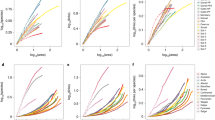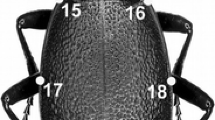Abstract
While much research in ecology has focused on spatially explicit modelling as well as on measures of biodiversity, the concept of spatial (or local) biodiversity has been discussed very little. This paper generalises existing measures of spatial biodiversity and introduces a family of spatial biodiversity measures by flexibly defining the notion of the individuals’ neighbourhood within the framework of graphs associated to a spatial point pattern. We consider two non-independent aspects of spatial biodiversity, scattering, i.e. the spatial arrangement of the individuals in the study area and exposure, the local diversity in an individual’s neighbourhood. A simulation study reveals that measures based on the most commonly used neighbourhood defined by the geometric graph do not distinguish well between scattering and exposure. This problem is much less pronounced when other graphs are used. In an analysis of the spatial diversity in a rainforest, the results based on the geometric graph have been shown to spuriously indicate a decrease in spatial biodiversity when no such trend was detected by the other types of neighbourhoods. We also show that the choice of neighbourhood markedly impacts on the classification of species according to how strongly and in what way different species spatially structure species diversity. Clearly, in an analysis of spatial or local diversity an appropriate choice of local neighbourhood is crucial in particular in terms of the biological interpretation of the results. Due to its general definition, the approach discussed here offers the necessary flexibility that allows suitable and varying neighbourhood structures to be chosen.
Similar content being viewed by others
References
Aguirre O, Hui G, von Gadow K, Jiménez J (2003) An analysis of forest structure using neighbourhood-based variables. For Ecol Manag 183: 137–145
Baddeley A (1998) Spatial sampling and censoring. In: Barndorff-Nielsen O, Kendall W, van Lieshout M (eds) Stochastic geometry, likelihood and computation. Chapman & Hall, London
Baddeley AJ, van Lieshout MNM (1995) Area-interaction point processes. Ann Inst Stat Math 47(4): 601–619
Bossdorf O, Schurr F, Schumacher J (2000) Spatial patterns of plant association in grazed and ungrazed shrublands in the semi-arid karoo, south africa. J Veg Sci 11(2): 253–258
Buckland S, Magurran A, Green R, Fewster R (2005) Monitoring change in biodiversity through composite indices. Philos Trans R Soc B-Biol Sci 28(360): 243–254
Cardinale B, Nelson K, Palmer M (2000) Linking species diversity to the functioning of ecosystems: on the importance of environmental context. Oikos 91: 175–183
Ceyhan E (2009) Overall and pairwise segregation tests based on nearest neighbor contingency tables. Comput Stat Data Anal 53: 2786–2808
Clark P, Evans F (1954) Distance to nearest neigbor as a measure of spatial relationships in populations. Ecology 35: 445–453
Condit R (1998) Tropical forest cencus plots. Springer, Berlin
Condit R et al (2000) Spatial patterns in the distribution of tropical tree species. Science 288: 1414–1418
Dixon P (1994) Testing spatial segregation using a nearest-neighbor contingency table. Ecology 75(7): 1940–1948
Gore A, Paranjpe S (2001) A course in mathematical and statistical ecology. Kluwer, Dordrecht
Hill MO (1973) Diversity and evenness: a unifying notation and its consequences. Ecology 54(2): 427–432
Hubbell S, Foster R, O’Brien S, Harms K, Condit R, Wechsler B, Wright S, de Lao SL (1999) Light gap disturbances, recruitment limitation, and tree diversity in a neotropical forest. Science 283: 554–557
Hubbell S, Ahumada J, Condit R, Foster R (2001) Local neighborhood effects on long-term survival of individual trees in a neotropical forest. Ecol Res 16: 859–875
Hubbell S, Condit R, Foster R (2005) Barro Colorado forest census plot data. http://www.ctfs.si.edu/datasets
Illian J, Penttinen A, Stoyan H, Stoyan D (2008) Statistical analysis and modelling of spatial point patterns. Statistics in practice. Wiley, New York
Law R, Dieckmann U (2000) A dynamical system for neighbourhoods in plant communities. Ecology 81: 2137–2148
Law R, Illian J, Burslem D, Gratzer G, Gunatilleke CVS, Gunatilleke IAUN (2009) Ecological information from spatial patterns of plants: insights from point process theory. J Ecol 97: 616–628
Lewandowski A, Pommerening A (1997) Zur Beschreibung der Waldstruktur—Erwartete und beobachtete Arten-Durchmischung. Forstwiss Centralbl 116: 129–139
Loreau M, Naeem S, Inchausti P, Bengtsson J, Grime J, Hector A, Hooper DU, Huston MA, Raffaelli D, Schmid B, Tilman D, Wardle DA (2001) Biodiversity and ecosystem functioning: current knowledge and future challenges. Science 294: 804–808
Magurran A (1988) Ecological diversity and its measurement. Princeton University Press, Princeton
Magurran A (2004) Measuring biological diversity. Blackwell, Oxford
Mahdi A, Law R (1987) On the spatial organization of plant species in a limestone grassland community. J Ecol 75: 259–476
Marchette DJ (2004) Random graphs for statistical pattern recognition. Wiley, New York
McGill BJ, Etienne RS, Gray JS et al (2007) Species abundance distributions: moving beyond single prediction theories to integration within an ecological framework. Ecol Lett 10: 995–1015
Møller J, Waagepetersen RP (2003) Statistical inference and simulation for spatial point processes. Chapman & Hall/CRC, London
Møller J, Waagepetersen RP (2007) Modern statistics for spatial point processes. Scand J Stat 34(4): 643–684
Morlon H, Chuyong G, Condit R, Hubbell S, Kenfack D, Duncan T, Valencia R, Green J (2008) A general framework for the distance-decay of similarity in ecological communities. Ecol Lett 11: 904–917
Motz K, Sterba H, Pommerening A (2010) Sampling measures of tree diversity. For Ecol Manag 260: 1985–1996
Okabe A, Boots B, Sugihara K, Chiu SN (2000) Spatial tessellations: concepts and applications of Voronoi diagrams. Wiley, New York
Patil G, Taillie C (1982) Diversity as a concept and its measurement. JASA 77(379): 548–561
Pielou EC (1961) Segregation and symmetry in two-species populations as studied by nearest neighbour relationships. J Ecol 49(2): 255–269
Pielou EC (1977) Mathematical ecology. Wiley, New York
Podani J, Czaran T (1997) Individual-centered analysis of mapped point patterns representing multi-species assemblages. J Veg Sci 8(2): 259–270
Reardon S, O’Sullivan D (2004) Measures of spatial segregation. Sociol Methodol 34: 121–162
Ripley BD (1977) Modelling spatial patterns. J R Stat Soc Ser B-Stat Methodol 39: 172–212
Scheiner S (2003) Six types of species-area curves. Glob Ecol Biogeogr 12(6): 441–447
Shimatani K (2001) Multivariate point processes and spatial variation of species diversity. For Ecol Manag 142: 215–229
Shimatani K, Kubota Y (2004) Quantitative assessment of multispecies spatial pattern with high species diversity. Ecol Res 19: 149–163
Stoyan D, Kendall WS, Mecke J (1995) Stochastic geometry and its applications. 2. Wiley, New York
Tóthmérész B (1995) Comparison of different methods for diversity ordering. J Veg Sci 6: 283–290
Tscheschel A, Stoyan D (2006) Statistical reconstruction of random point patterns. Comput Stat Data Anal 51: 859–871
Vuorinen V, Peltomäki M, Rost M, Alava M (2004) Networks in metapopulation dynamics. Eur Phys J B 38: 261–268
Waagepetersen RP, Guan Y (2009) Two step estimation for inhomogeneous spatial point processes and a simulation study. J R Stat Soc Ser B-Stat Methodol 71: 685–702
Wiegand T, Gunatilleke CVS, Gunatilleke IAUN, Huth A (2007) How individual species structure diversity in tropical forests. PNAS 104: 19029–19033
Author information
Authors and Affiliations
Corresponding author
Rights and permissions
About this article
Cite this article
Rajala, T., Illian, J. A family of spatial biodiversity measures based on graphs. Environ Ecol Stat 19, 545–572 (2012). https://doi.org/10.1007/s10651-012-0200-9
Received:
Revised:
Published:
Issue Date:
DOI: https://doi.org/10.1007/s10651-012-0200-9




